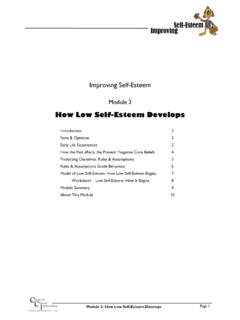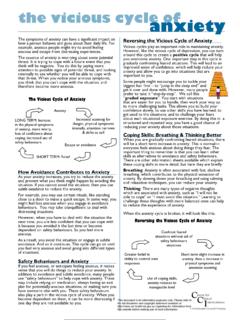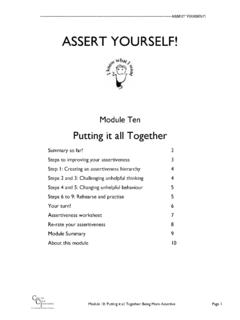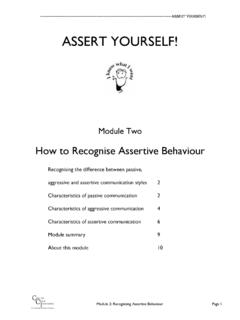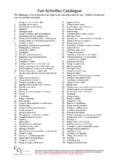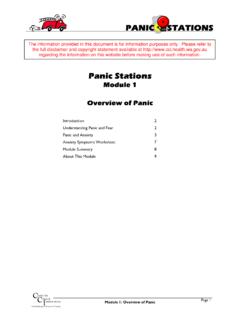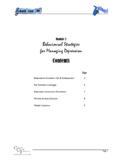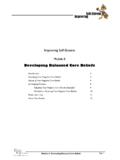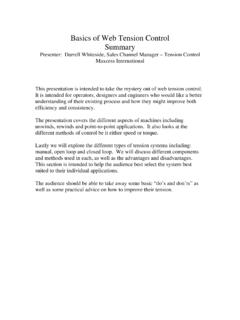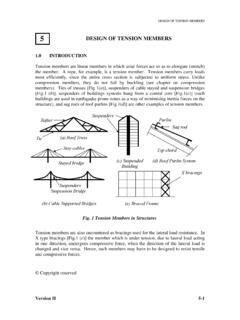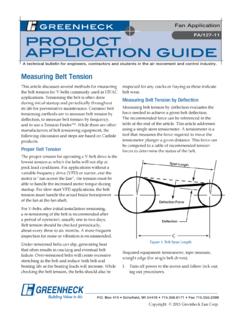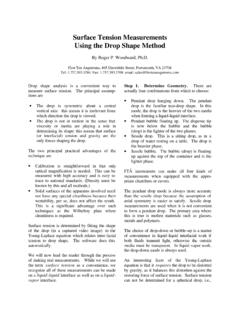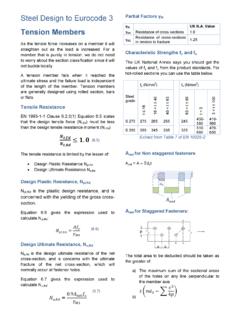Transcription of ASSERT YOURSELF! - Psychotherapy, Research, …
1 ---------------------------------------- ---------------------------------------- ------------------------------ ASSERT yourself ! ASSERT yourself ! Module Five Reducing Physical tension Physical tension 2. Identifying physical tension 2. Reducing physical tension 3. Progressive Muscle Relaxation 3. Mini relaxation 1 6. Mini relaxation 2 6. Slow breathing technique 7. Visualisation 7. Module summary 10. About this module 11. Centrelinical for C Interventions Module 5: Reducing Physical tension Page 1. Psychotherapy Research Training ---------------------------------------- ---------------------------------------- ------------------------------ ASSERT yourself ! Physical tension When we are communicating in a passive or aggressive way we are often feeling anxious or angry and this can be reflected in our bodies. We can become tense in our shoulders, necks, jaw or through our entire body. Over time this tension can build up to the point where we can get headaches, backaches, stomach problems, in fact a whole range of physical problems.
2 We also find it increasingly difficult to relax. To communicate assertively we must be able to control the arousal and tension that our bodies may feel when we are in difficult situations or situations in which we feel uncomfortable. Identifying Physical tension The first step in reducing physical tension is to identify where you hold it in your body. Have a look at the following table. Put a tick against each area that you feel tension in right now. Body Area tension (tick if yes). Scalp Forehead Eyes Temples Jaw Neck Shoulders Chest Upper arms Lower arms Hands Stomach Lower back Buttocks Thighs Calves Feet See if you can notice any patterns in the areas of tension . Are you mostly tense in your stomach and lower back, in your arms and legs, or around your neck and shoulders? You may want to repeat this exercise when you are in a more stressful situation to see if you are tense in the same areas or different ones. Centrelinical for C Interventions Module 5: Reducing Physical tension Page 2.
3 Psychotherapy Research Training ---------------------------------------- ---------------------------------------- ------------------------------ ASSERT yourself ! Reducing Physical tension Once people start to pay attention to their tension they are often surprised at how tense they really are. The good news is that there are a number of relaxation techniques that can be used to reduce physical tension . As with all the skills you are learning in these modules the more you practice them the more impact they will have for you. There are a number of techniques you can use to reduce physical tension . Some of these are listed below: Exercise Meditation Massage Guided Visualisation Progressive Muscle Relaxation Slow breathing Yoga Tai chi See if you can think of some activities that you know reduce your levels of tension and list them below. These may be the techniques or activities listed above or they may be more personal activities that you know reduce your tension such as listening to music or soaking in a bath.
4 While you are working through the rest of the modules see if you can do one of these tension reducing activities and exercises daily! _____. _____. _____. _____. In the rest of this module we will introduce you to some of the techniques that you may not have come across before. Progressive Muscle Relaxation Progressive muscle relaxation or PMR works through each of the muscle groups in progression. If we just try and relax muscles that have been tense for a while it can be difficult to get them to relax. Try it now. Try and just relax the muscles in your shoulders by Centrelinical for C Interventions Module 5: Reducing Physical tension Page 3. Psychotherapy Research Training ---------------------------------------- ---------------------------------------- ------------------------------ ASSERT yourself ! telling yourself to relax. Most people find this very difficult to do. PMR works by first tensing and then relaxing the muscles. Tensing the muscle first teaches you how to take control of the muscle and recognise the tension .
5 Try it now with your shoulders. Lift your shoulders up as high as you can and try to touch your ears with them. Hold that for 10 seconds. Now let them drop and feel the sensation of relaxation. This tensing and relaxing is followed for each of the major muscle groups. Follow each of the steps below for the different muscle groups. As we move through each body part you can use the same pattern of tensing and relaxing. When tensing a body part hold the tension for about 10 seconds. Then let the tension go and wait for another 10. seconds before you tense again. You may notice that you tend to breathe in as you tense and breathe out as you relax. This is the natural rhythm of the body and it is easiest if you keep following this. Breathe in as you tense, and breathe out as you relax. You may want to make a recording talking yourself through each muscle group so you can follow it without having to keep referring to the handout. First, get into a comfortable position in a chair.
6 It is better to do these exercises sitting up to prevent you from falling asleep. To work through the whole exercise should take about 15 to 20 minutes. Put both your feet flat on the floor and rest your hands gently on your legs. Allow your eyes to gently close. Become aware of the weight of your body, of your head, your shoulders, your arms, and your legs. Now clench your right fist tightly, noticing the tension as you do. Clench it tighter and notice the tension in your fist, hand and forearm. Now let go of the fist and relax your hand. Notice the contrast with the tension . Repeat this with your right fist. Then repeat with your left fist. Then tense both fists together. Now tense your lower arm muscles by lowering your hand. Bend it down at the wrist as though trying to touch the underside of your arm. Then relax the muscles by straightening the wrist again. Repeat. Centrelinical for C Interventions Module 5: Reducing Physical tension Page 4. Psychotherapy Research Training ---------------------------------------- ---------------------------------------- ------------------------------ ASSERT yourself !
7 Now bend your elbows and tense your biceps. Tense them as hard as you can. Feel the tension . Then relax and straighten out your arms. Repeat. Now move your attention to your shoulders. Tense your shoulders by lifting them up to try and touch your ears. Now relax by dropping them. Repeat. Now pull your shoulders forward while leaving your arms by your side. Hold and then relax by letting your shoulders go back to their normal position. Now move your attention to your neck. If you have a sore neck or a neck injury, check with your doctor or physiotherapist before doing this exercise. Gently lean your head to the left until you feel the muscles tighten in the right side of your neck. Slowly roll your head forward around to the right and then slowly back to the left. This exercise should not cause any pain. If you feel pain you are stretching the muscles too tightly, and you need to be a little gentler. Repeat. Now move your attention to your head. Wrinkle your forehead as tightly as you can.
8 It can help to lift you eyebrows. Hold this for 10 seconds and then relax. Now squint your eyes and hold that tension for 10 seconds. Relax, and then repeat. Now clench your jaw by biting your teeth together. Then unclench them and relax. When your jaw is relaxed your lips will be slightly parted. Really notice the difference between the tension and the relaxation. Repeat. Now press your tongue against the roof of your mouth. Then relax and let your tongue fall to the floor of your mouth. Repeat. Now press your lips together then purse them into an O shape. Relax your lips. Repeat. Make sure that the rest of your face is still relaxed. Now move your attention to your chest. Breathe in and fill your lungs completely and tense your chest muscles. Hold and then let your breath go completely and your muscles relax. Make sure your lungs are empty before you take in the next breath. Repeat. Now move your attention to your stomach. Tighten your stomach and hold. Note the tension then relax.
9 Now place your hand on your stomach. Breathe deeply into your stomach so that your hand is pushed out. Hold and then relax. Repeat. Now arch your back while keeping your head tilted forward. Feel the tension in your lower back. Hold then relax Centrelinical for C Interventions Module 5: Reducing Physical tension Page 5. Psychotherapy Research Training ---------------------------------------- ---------------------------------------- ------------------------------ ASSERT yourself ! and sit up straight again. Repeat. Now tighten your buttocks by pulling them together. You should rise in the chair slightly. Hold and then relax. Repeat. Now move your attention to your legs. Tense your thighs by pressing your heels into the floor as hard as you can. Hold and then relax. Repeat. Tense your calves by lifting your toes towards your shin. Hold and then relax. Repeat. Tense your feet by curling your toes into the floor. Hold and then relax. Repeat. When you have finished it is a good idea to stay sitting for a few minutes to really appreciate the sensation of relaxation.
10 Try not to stand up too quickly as you may tense up again. Also your blood pressure drops when you relax, so if you stand up too quickly you may get dizzy. Mini Relaxation 1. The more you practise the full PMR the more you will get to know the areas in your body that become tense. However, you won't always have 15 to 20 minutes to practice the whole exercise. In this case you can modify the exercise by just choosing the muscle groups that you know are tense and relaxing these. Mini Relaxation 2. Alternatively you could try this mini-relaxation exercise: 1. Stand up. 2. Lips closed, jaw relaxed, breathe slow and low down in your stomach 3. Breathe in for 2 seconds and out for 3 seconds. Be aware of your breathing for the whole exercise and keep it slow and deep. 4. Cross one of your legs over the other leg, keeping your feet firmly planted on the ground. Try to place your feet even with each other. 5. Put both your hands behind your back and grasp your hands.
